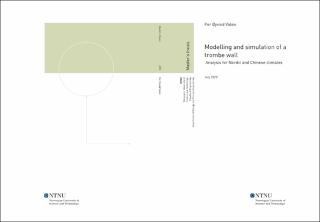| dc.description.abstract | I denne oppgaven blir en ventilert solvarmevegg analysert ved bruk av simuleringsprogramvaren TRNSYS, og Matlab. Arbeidet ble utført i samarbeid med Shanghai Jiao Tong University i Kina, som en del av Joint Research Centre in Sustainable Energy på NTNU og SJTU. Kandidaten sitt opphold i Shanghai, samt eksperimenter utført på Green Energy Lab på SJTU ble avbrutt som følge av Corona-viruspandemien.
I følge the International Energy Association så representerer byggenæringen 36 prosent av all årlig energibruk i verden. Dette tallet er forventet å stige, som følge av at totalt antall utbygd areal i verden stiger og at tilgang til energi i utviklingsland stiger hurtig. I en tid med mye politisk fokus på hvert lands total utslipp er arbeidet med å senke utslippene sentrale. Da er en mer miljøvennlig byggenæring veldig viktig. En måte å redusere byggenæringens utslipp på, er å bruke fornybare energykilder på kostnadsbesparende, enkle og miljøvennlige måter. I denne oppgaven blir bruken av en enkel solvarmevegg presentert. Denne solvarmeveggen blir kalt trombevegg.
I oppgaven presenteres et litteraturstudium utført for å få dypere innsikt i dagens status i den norske og
europeiske byggenæringen, energibruk i byggenæringen globalt, bruk av solenergi i bygg og studier utført på
trombevegglignende systemer. Det finnes mange studier på trombevegger, og det er tydelig at trombevegger
har potensiale. IDA ICE, Polysun, TRNSYS og Matlab blir vurdert som mulig simuleringsprogramvare til
prosjektet. Videre blir grunnleggende teori bak varmeoverføring gjennom stråling, konduksjon og konveksjon
gjennomgått, samt det matematiske grunnlaget til komponentene brukt i simuleringen. Grunnleggende teori og kilder som legger grunnlaget for trombeveggsimuleringen blir gjennomgått. Basisen for Matlab-scriptet blir også gjennomgått.
I kapittel 4, Method, presenteres arbeidet med å bygge opp simuleringen kronologisk. For å bedre finne feil og
mangler i simuleringen underveis bygges simuleringen opp delvis. Det enkle kontrollsystemet blir også
presentert. Enkel validering av simuleringen blir også gjennomført, ved brukt av eksperimenter funnet i litteratur.
En analyse av trombeveggens effekt i Kina og Norden blir gjennomført og presentert. Gøteborg i Sverige, Reykjavik på Island og Kashgar og Shanghai i Kina er valgt som lokasjoner. Dette er for å representere et varmt og et kaldt område fra både Kina og Norden. En årlig simulering, samt ukentlig sommer- og vintersimuleringer, blir gjennomført på alle fire lokasjoner. For å bedre hjelpe arbeidet med videreutvikling av trombevegger presenteres påvirkningen trombeveggens og luftåpningens tykkelse har på effekten av veggen, i Shanghai og Gøteborg. En drivhusgassanalyse blir gjennomført, og alle lokasjonene blir kalkulert som miljøvennlige. Til slutt blir simuleringens treffsikkerhet gjennomgått, og lærdommen fra resultatene presentert videre. Anbefalt videre arbeid med trombevegger presenteres til slutt.
Matlab-scriptet som legger grunnlaget for simuleringen legges ved i sin helhet. | |
| dc.description.abstract | According to the International Energy Association, the building sector represents 36 percent of the yearly total final energy demand in the world. This number is expected to continue to rise, with the ever-increasing global building floor area and the rising demand for and access to energy in developing countries being two of the main reasons. And, in today's political landscape, with the growing global focus of lowering each country's total energy use, the benefits of a more energy-efficient building sector is evident. One way to reduce the energy need of a building, is to utilize some of the renewable energy sources in a cost-effective, realistic and environmentally friendly manner. In this assignment, the use of a simple solar power installation will be researched. The installation is called a trombe wall.
The work presented in this report consist of a literature review, a review of the relevant theory, the setup of a simulation, validation, calibration, and results from the simulation and an assessment of further work on this project. The literature review section begin by presenting the current status of the research and regulations on the energy demand of buildings. Subsequently the worldwide research into trombe wall, solar heating wall and solar chimney technology is presented, to clarify which aspects of the trombe wall that is firmly established in literature and which should be researched further by the author. At the end, different simulation software is presented, as choosing a fitting simulation software is crucial for the project. IDA ICE, Solar Plus and TRNSYS are found to be the three most relevant software.
In the theory section, basic physical mechanics and governing equations in the system is presented. Radiation, conduction and convection heat transfer modes is presented briefly. Then, some aspect of the simulation of building simulation are presented. It is presented generally, and specifically on how TRNSYS operates. The mathematical foundations of different components of the TRNSYS simulation are also presented. The framework for doing green house gas emission calculations is presented as well.
The control strategy for the simulation is presented as well. To validate the simulation, some recreation of experiments from literature is performed and presented in this section.
In the method section, the work with producing the simulation is presented chronologically. The simulation was defined step by step, with the purpose of testing and verifying the simulation by comparison to literature at each major step. This was to prevent large inaccuracies in vital components of the simulation, and to ease error detection when creating the simulation. Here, the viability of each simulation is discussed, and key parameters are measured against relevant numbers from sources presented in the literature review. A more thorough validation is performed as well, by replicating experiments found in litterature.
The result section details the results from the different simulation. Four different locations, two in China and two in the Nordic countries are simulated and presented. Summer and winter simulation for each of these locations, as well as simulations for different slit and wall sizes are presented as well. These results are discussed in this section. In the discussion section, sources of error in the simulation is presented. More broad results from the simulations is discussed as well, and further work is discussed. | |
